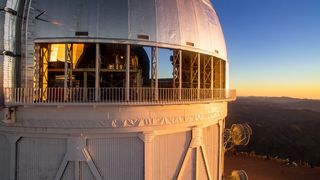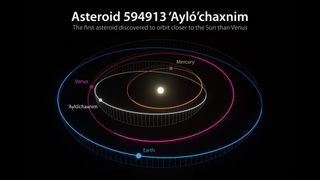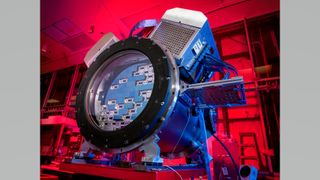'Twilight telescope' finds 'city killer' asteroid in unexplored region of our solar system
When it comes to searching for asteroids, we have a blind spot. It may seem counterintuitive, but the asteroid’s most important discoveries are now being made at dusk, when astronomers can see up close to the horizon – and close to the sun – for what little is known. asteroids orbiting within the orbits of Earth, Venus and even Mercury.
In perspective published in Science today, asteroid hunter Scott Sheppard of the Carnegie Institution of Science highlights the new “twilight telescope” surveys and the riches they are beginning to discover. It includes the first asteroid with an interior orbit to Venus and the one with the shortest known orbital period around the sun, both of which have been unearthed in the past two years. It also includes “city killers”, asteroids large enough that if they hit Earththe damage will be severe.
“We’re doing a full survey looking for anything moving around the orbit of Venus, which is somewhere we haven’t surveyed very deeply in the past with anything other than a tiny one-meter telescope,” Sheppard, who runs the twilight survey using Dark Energy. Camera (DECam) on the Víctor M. Blanco 4-meter Telescope at the Cerro Tololo Inter-American Observatory (CTIO) in Chile, told Space.com. “This is quite difficult to do and generally the larger telescopes don’t have a very large field of view so you can’t cover much of the sky.”
However, DECam and other telescopes make it easier to investigate the previously hidden world of asteroids that had hitherto been obscured by sundazzled.
Related: How many asteroids are threatening there? Complicated.
Why look for asteroids at dusk
About 30 years of methodical searching in the sky has resulted in the discovery of most of the asteroids 3 miles (5 kilometers) wide. Models and surveys show that more than 90% of “planet-killing” Near-Earth Objects (NEOs) (those greater than 0.6 miles, or 1 km) have been found, but only about half of “city killer” NEOs (larger than 460 feet, or 140 meters) is known.
So where’s the rest? “There will be others either close to the sun, very difficult to observe, or in the same orbit as Earth that makes them difficult to find by normal surveys,” said Sheppard. Their eccentric orbit makes them only visible in the twilight sky.
Sheppard’s team has identified a medium-sized asteroid, called 2022 AP7, whose orbit crosses Earth, matching the criteria for a “potentially hazardous asteroid.” But others, most likely, can still be found. “The main reason we haven’t found all the ‘city killers’ is because we haven’t looked at the sky at the same depth for years to find them,” said Sheppard.
asteroid language
Near-Earth asteroids come in a variety of flavors, all determined by the orbital characteristics of the space rock. For example, Amor approaches Earth, but never crosses its orbital path around the sun, so it poses no danger to us.
Not so with the asteroid Apollo, which crosses Earth’s orbit, but mostly lies beyond it. This category includes likes from Apophis and Bennuand these space rocks generally orbit the sun just outside the Earth’s orbital path, meaning that surveys of wide-field telescopes operating at night are best done for viewing these asteroids.
Other categories of near-Earth asteroids are much harder to find, such as Atens (which cross Earth’s orbit and remain largely within it), Atiras (also called Apohele, which orbits interior to Earth’s orbit) and Vatiras (which orbits in an orbital path). . from the planet Venus). However, Sheppard’s survey – which uses just 10 minutes of telescope time just after sunset and before sunrise to look for those close to the sun – yielded some surprises.
The only true ‘Venus Girl’
So far astronomers know of only one Vatiras space stone.
Asteroid 2020 AV2 was discovered on January 4 using the Zwicky Transient Facility (ZTF) telescope at the Palomar Observatory near San Diego, California. The facility is on the ancestral land of the Pauma indigenous group, who were asked to name it. They choose ‘Ayló’chaxnim, meaning “Venus Girl” in their Luiseño language.
The asteroid is between 0.6 miles and 1.9 miles (1 to 3 km) wide, orbiting on a path inclined 15 degrees relative to the asteroid’s plane. solar system, and takes 151 days to orbit the sun. Scientists suspect the asteroid may have been thrown into Venus’ orbit after a close encounter with another planet.
The sun’s closest neighbor
In the evening hours of August 13, 2021, Sheppard discovered the asteroid with the shortest orbital period. Captured in data from DECam, asteroid 2021 PH27 is about 0.6 miles wide and its surface may heat up to about 930 degrees Fahrenheit (500 degrees Celsius)—hot enough to melt lead—as its 113-day orbit brings it as close as 12 degrees. million miles (20 million km) from the sun. Only Mercury has a shorter orbit than the sun, at 88 days. However, because its orbit crosses the orbits of Mercury and Venus, this asteroid is classified as Atira.
2021 PH27 could become an extinct comet, scientists think, given its orbit is tilted from the solar system’s main plane by 32 degrees. The tilt suggests that the object may have come from the outer solar system, sent into a closer orbit around the sun after passing near one of the terrestrial planets.
top ‘twilight telescope’
ZTF and DECam are the places to go when looking for asteroids orbiting interior to Venus.
You might think that the bigger the telescope, the better for hunting for asteroids, but a larger telescope has a smaller field of view. ZTF, which is rapidly scanning the sky, has so far spotted one Vatira and several Atira asteroids. DECam, a 570-megapixel CCD imager designed for the Dark Energy Survey (DES) has discovered several Atira asteroids, including 2021 PH27. The ZTF has a larger field of view, but the DECam can see objects that are much dimmer in brightness as measured by magnitude.
“DECam changed everything,” said Sheppard. “We’re now going deeper than anyone has ever done before – we’re opening up new areas of space that we can monitor constantly that haven’t been really well monitored in the past.”
Look forward to hearing more about the new asteroids discovered in this unexplored region of our solar system.
Jamie Carter is a writer “Stargazing Program For Beginners (opens in a new tab)” (Springer, 2015) and he edited WhenIsTheNextEclipse.com. Follow him on Twitter @jamieacarter. Follow us on Twitter @Spacedotcom or on Facebook.
#Twilight #telescope #finds #city #killer #asteroid #unexplored #region #solar #system



Comments
Post a Comment